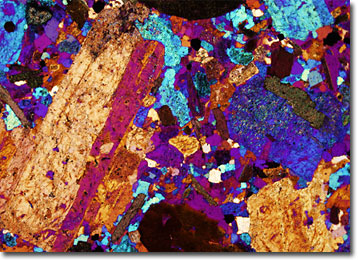Polarized Light Microscopy Digital Image Gallery
Quartz Monzonite Porphyry
Porphyries are rocks that contain large, conspicuous crystals in a finer groundmass of minerals. Quartz monzonite, also known as adamellite, is just one of many different varieties of rocks that frequently occur as porphyries.

Quartz monzonite is a granitic rock that is primarily composed of quartz, plagioclase feldspar, and orthoclase feldspar. Other minerals, such as biotite and hornblende, are also typically present in small amounts. Abundant and widespread, the intrusive igneous rock may be found in tremendous masses in many mountainous areas. Quartz monzonite is also frequently involved in gorge formation since it is extremely resistant to weathering and stands tall as surrounding rocks erode away. Indeed, a prime example of this type of gorge is the Black Canyon of the Gunnison in Colorado, which owes its steep walls to the hardness of the rock that has successfully withstood the force of the Gunnison River for two million years.
Due to its many beneficial characteristics, quartz monzonite is sometimes utilized as a building stone. In fact, the material, which was particularly popular in the Mediterranean area in ancient times, was used to help erect the Capitol building in the state of Utah. Constructed between 1913 and 1915, the important political edifice required approximately eight hundred railroad carloads just to create the stately exterior. The massive amounts of rock fittingly came from Utah deposits in Little Cottonwood Canyon.
